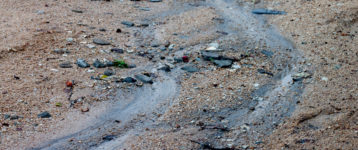A seepage pit often goes hand-in-hand with a septic tank system, creating a porous masonry area where household waste can be collected and gradually seep into the ground. If a conventional septic system won’t work or there isn’t access to a main sewer system in the area, then a seepage pit can be a great alternative.
While the use of seepage pits can be helpful, there are specific considerations that need to be made to protect the environment. The location, structure, and overall design of the seepage pit must be strategically planned to avoid toxic waste that can harm the surrounding areas.
Seepage pits are designed with walls to contain the wastewater, then filled with gravel to allow for optimal draining. Additionally, the gravel is beneficial for reducing clogging by minimizing the dirt that comes in contact with the walls.
Here are a few essential environmental considerations that need to be addressed when designing and installing a seepage pit.
1. Location and Site Selection
Sufficient space and an ideal location must be selected for the seepage pit placement. When selecting a location, it’s important to consider other features and buildings in the area. For example, the rule of thumb is that a seepage pit should be more than 100 feet from the nearest well to avoid water contamination.
If other buildings are in the area, then the seepage pit must be at least 20 feet away. The area between the seepage pit and the house must be unobstructed. Also, a minimum of 10 feet needs to be between the lot line and the pit.
You should also consider the area’s slope in relation to the house and other buildings. Never build a seepage pit where the slope runs down to the house. Instead, the house should be higher than the pit, allowing gravity to support the natural processes.
2. Soil Permeability
How well will the wastewater permeate into the soil? If the soil is more permeable, then it means that the seepage will be more significant. As a result, a smaller seepage pit might be sufficient. The permeability of the soil plays an integral role in the seepage process and the way everything can filter through the pit.
The best type of soil to support seepage is a more sandy material. When you pick up a handful of the soil, you will see that it will easily crumble and clods will fall down. If the soil is dry, hard, dense, or difficult to dig into, then it means that the soil is nonabsorbent.
Check the soil on your property by turning a few shovels of soil in several areas. When you find an area with the ideal type of soil, then consider digging a small hole to test the effectiveness before undertaking a full seepage pit installation.
3. Size and Depth
The depth of the seepage pit depends on the soil conditions in the area. It’s also essential to know where the groundwater is located. Seepage pits must be located more than 2 feet above the groundwater. If there is impermeable bedrock, then the seepage pit must end at least 5 feet above this rock.
4. Vegetation
Evaluate vegetation in the area near the seepage pit. Because hazardous waste can be present in the runoff water, be careful to avoid water that runs into areas with trees and other types of vegetation. These vegetation features need to be protected so the trees and plants aren’t killed off by the drainage.
5. Regulatory Compliance
Various regulatory requirements must be met in accordance with area permitting and compliance needs. For example, your municipality might have specific guidelines for system components, necessary clearances, or other specifications that must be met in the design of the seepage pit.
Most property owners don’t know about these compliance requirements, which is why it is essential to lean on the experience and recommendations of a knowledgeable contractor.
Not only are you hiring a contractor to help with soil testing and seepage pit excavation; but the right contractor, such as our team at Mikula Contracting, can also offer advice about obtaining the necessary permits and other requirements before construction can begin. Going through the proper channels and local municipalities helps to minimize the risk of fines and penalties for the project.
Let Mikula Contracting Help
Whether you are installing a septic system or adding a seepage pit, it pays to hire the experts. Many different factors need to be considered to ensure the effectiveness and safety of this system.
Our team at Mikula Contracting offers seepage pit installation and upgrades, and we also provide a full range of other services for your property, such as soil remediation, excavation, and more. We invite you to reach out for a consultation to discuss the possibilities with an expert team in the industry. We are always here to help!



